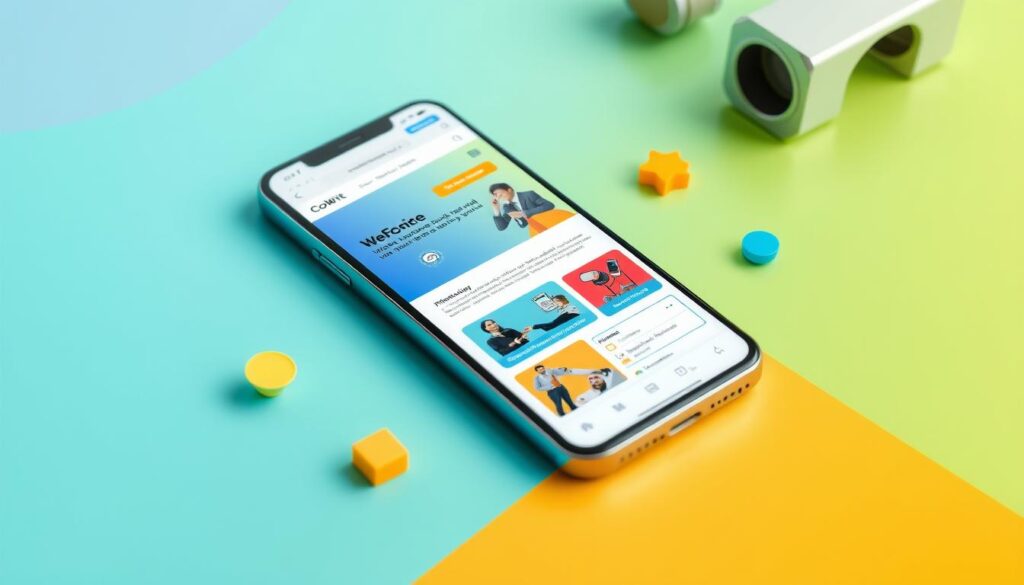In today’s world, more people use smartphones and tablets. Having a responsive website is key for businesses to succeed. Responsive web design services make websites work well on all devices, giving users a great experience and boosting engagement.
Responsive web design uses fluid grids, flexible images, and media queries. This ensures your website looks and works great on any device. It makes sure your site is easy to use, no matter how you access it.
Choosing responsive web design services can greatly benefit your business. You’ll see better mobile user experience, one URL for all devices, lower bounce rates, and faster loading times. These improvements help your site rank better in search engines and make it more visible online.
Key Takeaways
- Responsive web design enhances user engagement by up to 60% on average.
- Websites with responsive design experience a 40% higher conversion rate compared to non-responsive websites.
- 70% of website traffic comes from mobile devices, underscoring the necessity of responsive web design.
- Responsive web design can increase the average time spent on a website by up to 30%.
- Responsive web design services aim to offer exceptional user experience on devices with different screen sizes.
Understanding Responsive Web Design
Responsive web design makes sure websites look good on all devices. This includes desktops, laptops, tablets, and smartphones. It’s all about making sure users have a great experience, no matter what they’re using.
What is Responsive Web Design?
Ethan Marcotte introduced responsive web design in 2010. It changes how a website looks based on the device being used. It uses fluid grids, flexible images, and media queries to make websites work well on any device.
Key Principles of Responsive Design
- Fluid Grids: A flexible layout that changes with the device and screen size.
- Flexible Images: Images that grow or shrink to fit the space, making visuals smooth.
- Media Queries: CSS rules that adjust styling based on device characteristics, for better adaptive content delivery.
Benefits of a Responsive Approach
Responsive web design has many advantages. Here are a few:
- Improved Mobile Experience: It makes websites easy to use on phones, keeping users engaged.
- Single URL for All Devices: You don’t need different sites for phones and computers, making things simpler.
- Enhanced SEO Performance: Google likes websites that work well on phones, so they rank better.
- Reduced Development Costs: With one codebase for all devices, making websites is faster and cheaper.
By using responsive design, businesses can give users a great experience on any device. This makes for happy customers and a successful website.

Importance of User Experience in Web Design
Making a great user experience (UX) is key for any website or app to succeed. Good UX keeps users interested and coming back. It makes their journey smooth and enjoyable.
Defining User Experience (UX)
User experience covers everything a user does on your site, from start to finish. It includes intuitive navigation, seamless user journeys, and user experience optimization. A good UX tells search engines your site is useful and engaging, which can help your ranking.
How UX Affects Engagement
A good UX makes users want to stay longer and explore more. When your site is easy to use, users are less likely to leave quickly. This can lead to more people staying on your site, better conversion rates, and stronger loyalty to your brand.
UX Design Best Practices
- Make sure your site is easy to navigate and has a clear layout.
- Ensure your site loads quickly and works well on all devices.
- Use design that everyone can use, no matter their abilities.
- Use design that focuses on the user, like good layout and colors.
By following these UX design tips, you can make a website that users love. It will also tell search engines that your content is valuable and engaging.
“We grew to 100k/mo visitors in 10 months with AIContentfy” – Founder of AIContentfy

| UX Design Element | Impact on Engagement |
|---|---|
| Intuitive Navigation | Reduces user effort and frustration, encouraging longer sessions and repeat visits. |
| Fast Loading Times | Minimizes user waiting and improves overall satisfaction, reducing bounce rates. |
| Accessible Design | Broadens the audience reach and fosters inclusivity, enhancing user engagement. |
The Role of Mobile Optimization
In today’s world, mobile devices are a big part of our lives. The need for mobile optimization is huge. Businesses that focus on responsive web design and mobile-friendly sites will do well.
Why Mobile Matters
More people use mobiles than desktops for the internet. This change happened a few years ago. Google started focusing on mobile sites in 2018. If you don’t have a mobile-friendly site, you’ll miss out on customers and visibility.
Features of Mobile-Friendly Design
- Responsive layouts that adapt to any screen size
- Touch-friendly navigation and interfaces
- Fast-loading images and media
- Simplified content for easy reading
- Clear call-to-action buttons for better conversions
Trends in Mobile Usage
Smartphones have changed how we use the internet. Most internet users now use mobiles. Sites need to work well on small screens.
This change has led to new trends. For example, Progressive Web Apps (PWAs) and voice search are becoming more important.
“Over 50% of web traffic comes from mobile devices, highlighting the importance of aligning SEO strategies with mobile search trends.”
By using responsive web design and mobile-friendly sites, businesses can improve user experience. This leads to better engagement and more sales. Keeping up with mobile trends is key to staying competitive online.

Techniques for Enhancing User Engagement
In today’s fast-changing world of website design, it’s key to keep users engaged. By using smart strategies, you can make your site both fun and eye-catching. This will keep your visitors interested and coming back for more.
Interactive Elements
Add cool stuff like sliders, calculators, or interactive infographics to your site. These features catch the eye and make users want to dive in. A Google study found that over half of all web visits are from mobiles. So, make sure your site works well on phones too.
Use of Visual Content
Using top-notch visuals like images, videos, and animations can really boost engagement. A study found that adding images to website pages can increase interest by up to 94%. Good visuals can also make text easier to read and more fun to look at.
Effective Call-to-Actions
Clear and strong call-to-actions (CTAs) are great for guiding users and getting them to take action. Make your CTAs stand out, be clear, and match what your users want. Try different designs and spots to see what works best.
By using these tips, you can make your website more engaging and fun. This will not only keep users interested but also help your business grow.
Tools and Technologies for Responsive Design
Responsive web design is key for success online today. Web designers and developers use many tools and technologies to make websites work well on all devices. This ensures websites look great on phones, tablets, and computers.
Popular Web Design Frameworks
Bootstrap is a top choice for data-driven design. It’s an open-source toolkit with HTML, CSS, and JavaScript components. These make it easy to build websites that work well on all devices.
Designers use Bootstrap’s grid system and responsive utilities. This helps their content look good on any screen size.
Testing and Debugging Tools
It’s important for websites to work well on all devices. Tools like Google’s Chrome DevTools and Mozilla’s Firefox Developer Tools help a lot. They let designers test their websites on different devices and screen sizes.
These tools help find and fix problems with layout, typography, and functionality. This ensures a good user experience on all platforms.
Content Management Systems
Content management systems (CMS) like WordPress, Drupal, and Joomla are very helpful. They offer responsive-ready themes and templates. They also have plugins for creating mobile-optimized content.
Using a CMS lets designers focus on creating great user experiences. They don’t need to worry about complex coding.

With these tools and technologies, web designers can make websites that are engaging and work well on many devices. This helps attract and keep users interested.
Best Practices for Implementing Responsive Design
In today’s digital world, having a strong responsive web design is key for businesses. It helps improve user experience and keeps users engaged. By following these best practices, your responsive design will stay effective and current.
Conducting a Responsive Audit
Regular audits are vital to check how your website works on different devices and sizes. You’ll look at layout, content, and tech to find ways to get better. This keeps your site smooth for all users, no matter the device.
Collaborating with Designers and Developers
Good responsive design needs teamwork between designers and developers. This teamwork ensures your site looks great, works well, and is doable. It helps solve problems early and keeps the user experience consistent everywhere.
Continuous Improvement Strategy
Responsive web design is a never-ending task, not just a one-time job. As tech and user needs change, so must your design strategy. Stay open to feedback, watch industry trends, and update your site regularly to keep it engaging.
| Responsive Design Metric | Industry Benchmark | Your Website |
|---|---|---|
| Mobile Traffic Share | 60% | 75% |
| Bounce Rate | 40% | 35% |
| Conversion Rate | 2.5% | 3.2% |
| Load Time | 3 seconds | 2.8 seconds |
By following these responsive design tips, your website will stay top-notch for users. This leads to better results for your business.
“Responsive design is no longer an option – it’s a necessity in today’s mobile-first world.”
Case Studies: Success Stories in Responsive Design
Responsive web design has changed the game for businesses. It boosts website engagement and user experience. Many real-world examples show the benefits of responsive design.
Example 1: Increased Engagement Metrics
Airbnb’s bookings from mobile devices doubled in the first year with responsive design. Instagram’s responsive web design also helped it grow, especially on desktops.
Example 2: Improved Conversion Rates
Dropbox saw a 10% boost in conversions with a clean, responsive design. Etsy’s mobile and tablet traffic jumped 20% after going responsive.
Example 3: Enhanced User Satisfaction
Pinterest’s responsive design increased search traffic by 15% and boosted user engagement. A Google study shows users are five times more likely to leave a non-mobile-friendly site.
These stories show the big wins of responsive web design. They include more engagement, better conversion rates, and happier users. Businesses that go responsive get ahead by offering great experiences on all devices.
Future Trends in Web Design
Web design is getting a big boost from new technologies and fresh ideas. We’re seeing more artificial intelligence (AI) and machine learning. Voice user interfaces (VUIs) and personalized experiences are also on the rise. This makes the future of web design both thrilling and groundbreaking.
The Rise of AI and Machine Learning
AI and machine learning are set to change web design a lot. They’ll help make websites more personal and flexible. With AI, websites can change to fit what each user likes, making their experience better.
Voice User Interfaces
More devices are becoming voice-enabled, like smart speakers. This means web design will focus more on voice user interfaces (VUIs). Designers will work on making websites easier to use without touching them, making things more intuitive.
Personalized User Experiences
Personalization is becoming a big deal in web design. Companies want to give users experiences that feel made just for them. By using data and AI, websites can adjust to what each user likes, making their visit more enjoyable.
These new trends in web design, like AI, VUIs, and personalization, are making websites better. They help businesses create sites that are more about the user. By using these new tools, designers can make websites that are more engaging, improve sales, and stand out in a crowded market.
Choosing the Right Responsive Web Design Services
When picking a web design service, look at their experience and what they offer. Make sure they create websites that look good and work well on all devices. It’s important they focus on making your website easy to use on any device.
Evaluating Service Providers
Check the work history of potential web design providers. They should have a track record of successful projects. Also, see if they focus on keeping your website running smoothly over time.
Key Features to Look For
Look for services that improve your website’s user experience and search engine ranking. They should offer SEO, mobile-friendly design, and flexible layout for different devices. This ensures your website looks great on any screen size.
Questions to Ask Before Hiring
Ask important questions before hiring a web design service. Find out how they improve user experience and keep up with design trends. Also, ask about their approach to making your website work well on all platforms.



